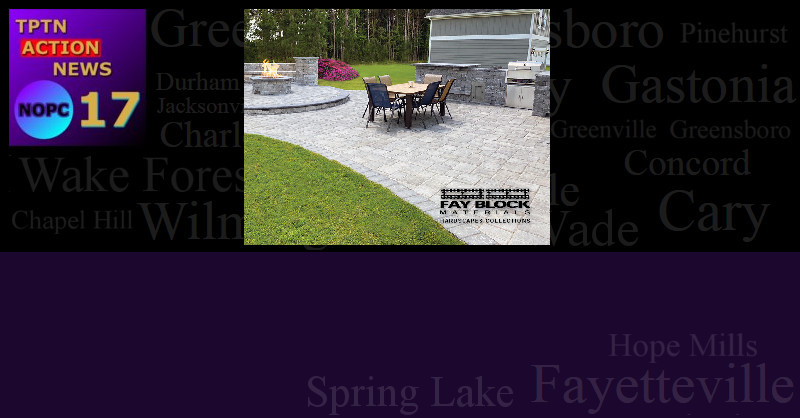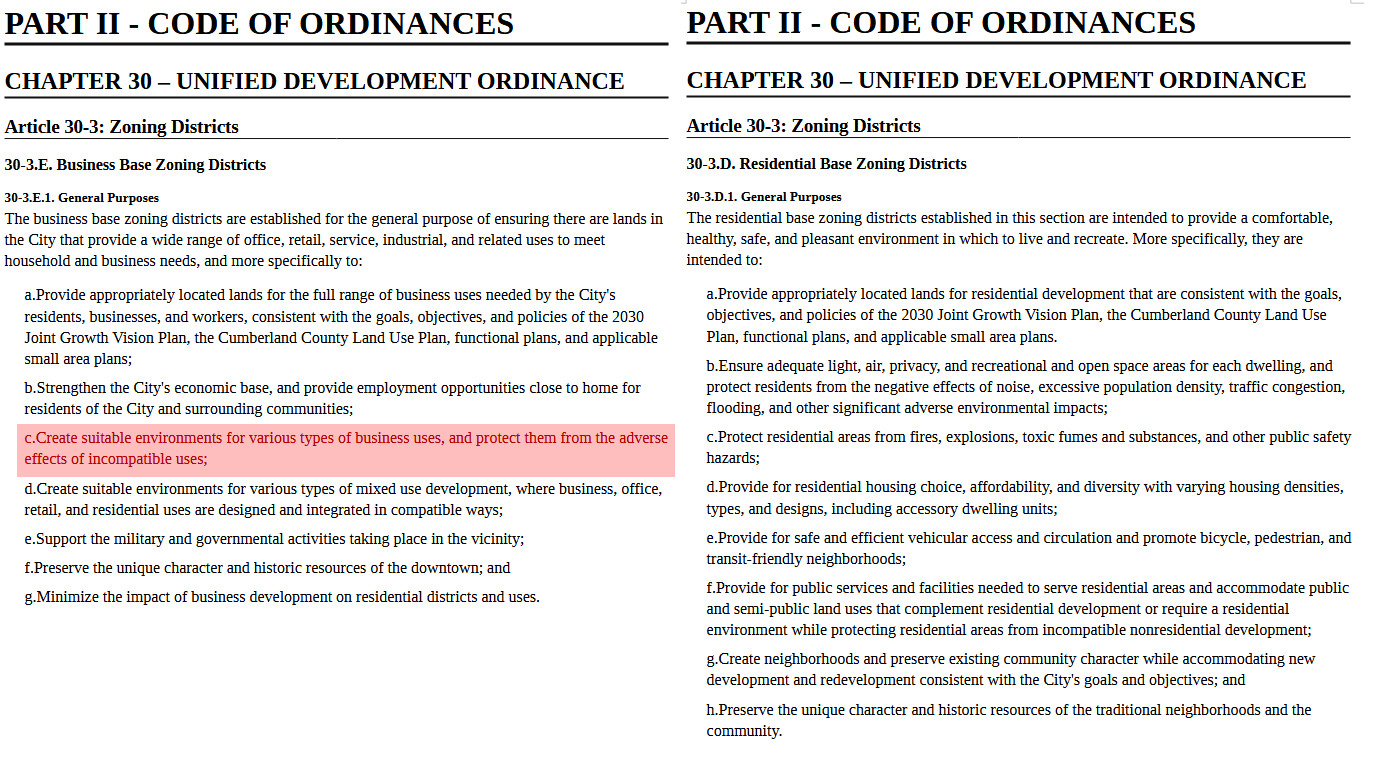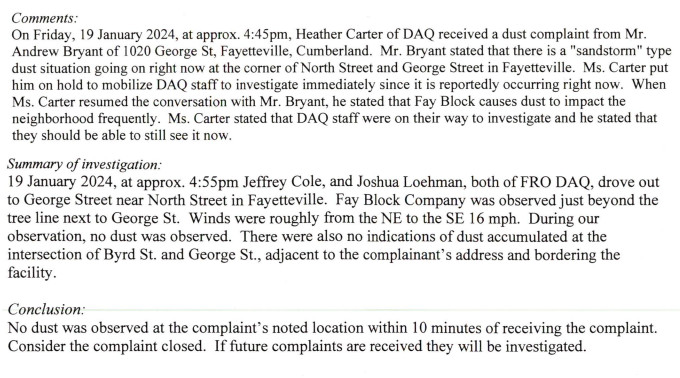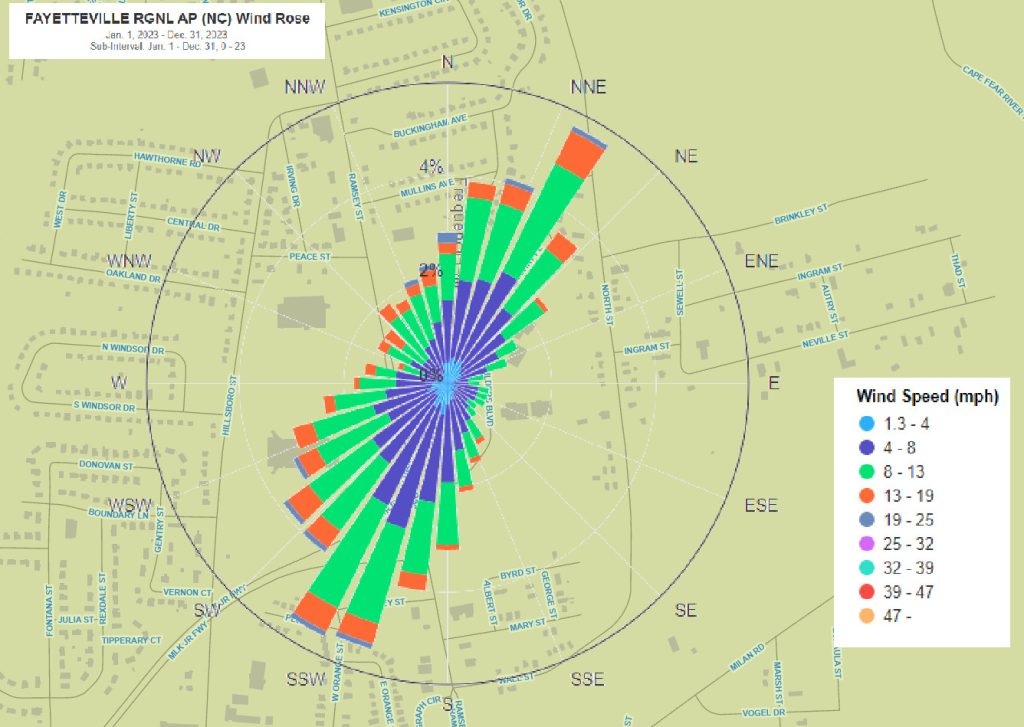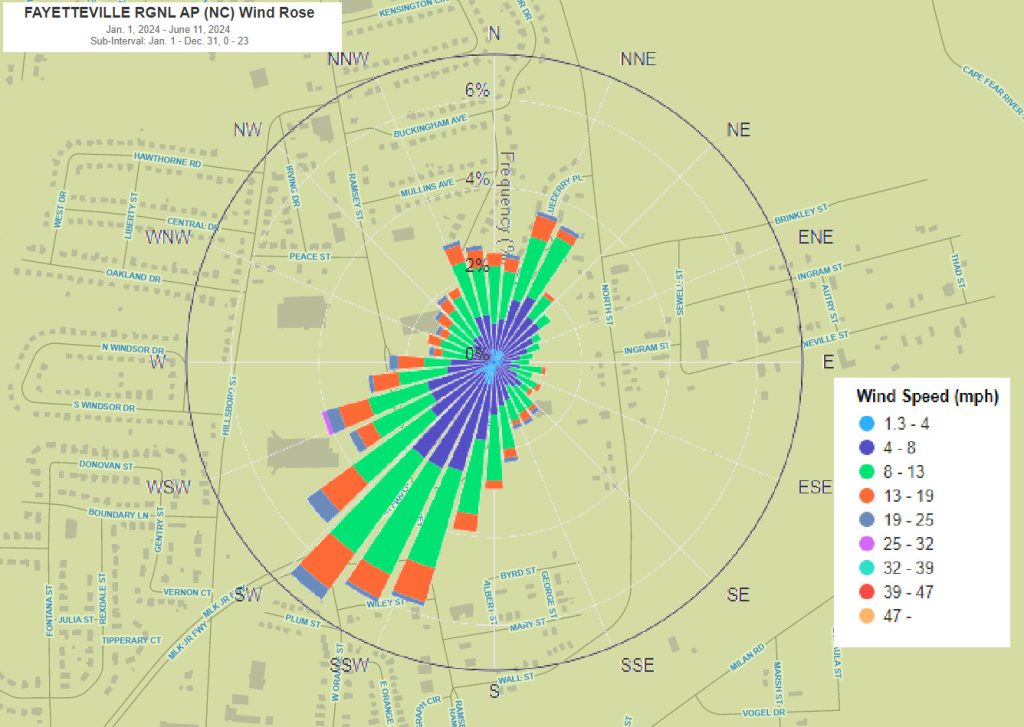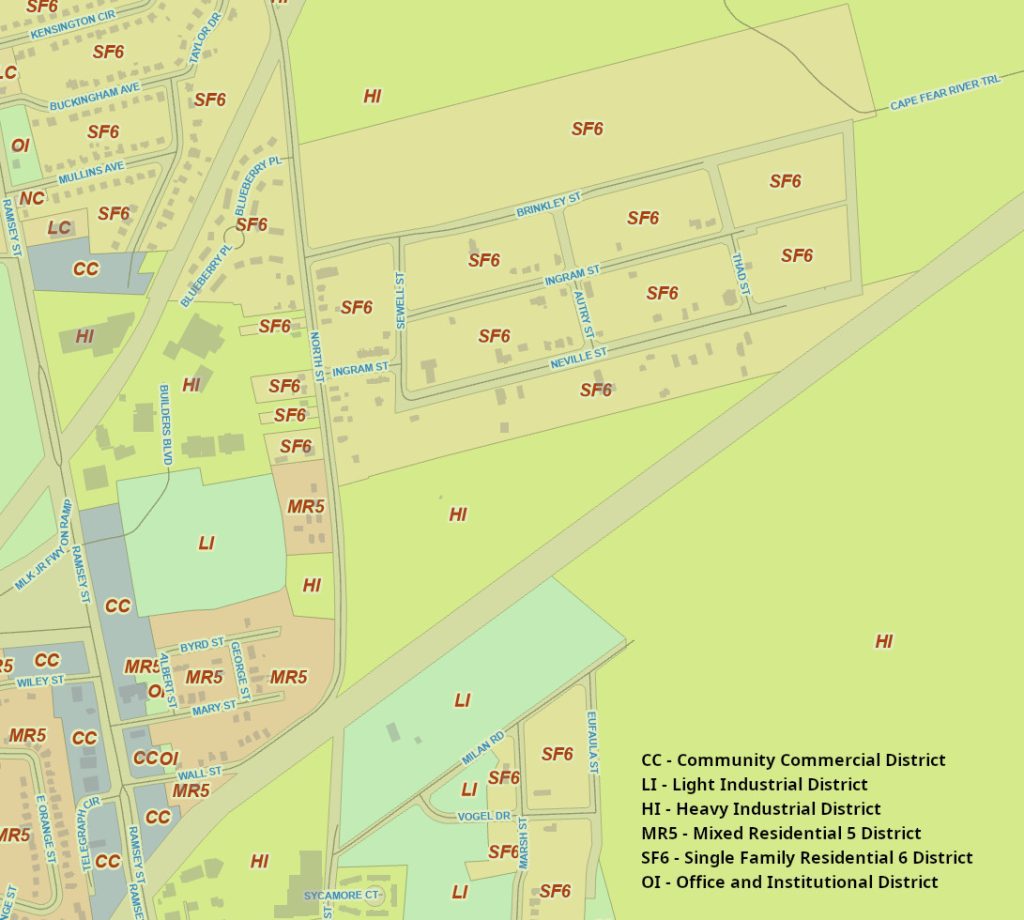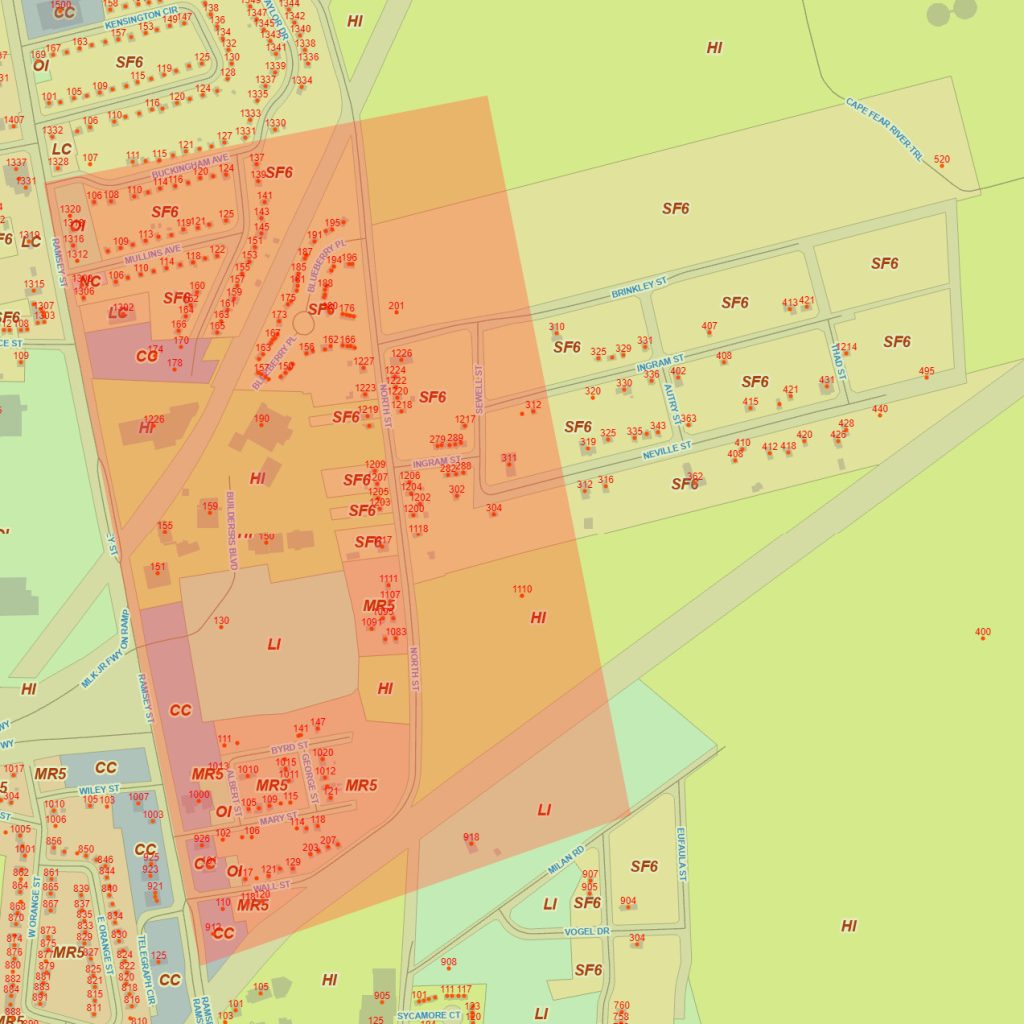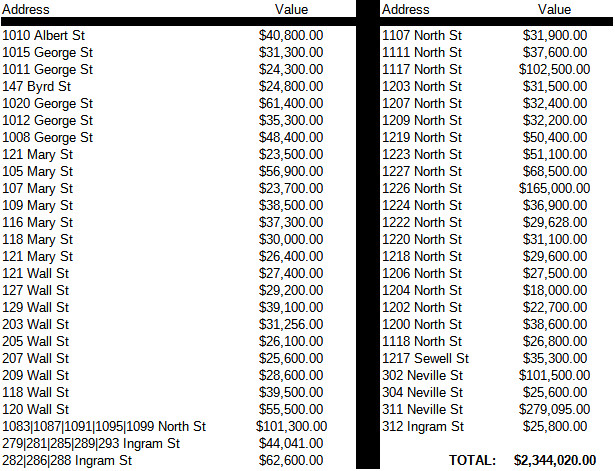Amortization; Solution to an Endangered Neighborhood
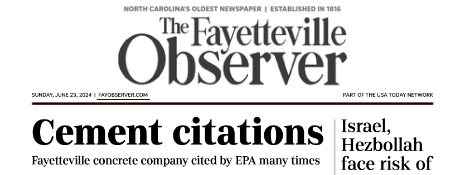 Fayetteville, N.C. – Despite Myron Pitt’s opinion hit piece and the latest lies that Fay Block Materials has been “cited many times”, several key community stockholders in collaboration with governmental departments have been researching reasonable common sense legal solutions to the issue.
Fayetteville, N.C. – Despite Myron Pitt’s opinion hit piece and the latest lies that Fay Block Materials has been “cited many times”, several key community stockholders in collaboration with governmental departments have been researching reasonable common sense legal solutions to the issue.
First, a Word About Our ‘Editor’:
At TPTN, we are deeply concerned by the existence of news outlets that selectively report information to advance hidden agendas driven by distorted views on race, gender, or other biases, rather than providing the full, unbiased truth. This commitment to transparency and integrity is precisely why TPTN was founded.
Throughout history, many influential works have been published anonymously or under pseudonyms. For example, “The Federalist Papers,” advocating for the ratification of the U.S. Constitution, were published under the pseudonym “Publius.” “Common Sense”, a pamphlet advocating American independence from Britain, published in 1776 and one of the most influential works in American history, was published under the pseudonym “An Englishman.”
The anonymity did not diminish their impact or importance. The primary concern when evaluating an article should be the quality, accuracy, and relevance of its content. Information should be assessed based on its factual correctness, logical consistency, and how well it is supported by evidence. In order to conduct an objective evaluation, readers should be encouraged to critically evaluate the arguments and data presented in an article, rather than relying on the author’s identity as a proxy for credibility.
Knowing an author’s name can introduce bias. Readers might judge the content based on their preconceptions about the author rather than the merits of the article itself. A perfect example of this is when readers see Myron Pitts’ name attached to his opinions and automatically assume that it’s another racially biased article. Anonymity can help ensure that the focus remains on the information and arguments presented. The value of ideas should stand on their own merits, not on the reputation or identity of the person presenting them. This encourages a more meritocratic approach to knowledge dissemination.
Anonymity can protect authors who might otherwise be at risk of personal or professional repercussions. This is particularly important for whistleblowers, activists, or individuals from marginalized groups who may face backlash for their views. Allowing articles to be published without identifying the author can help diversify the range of voices and perspectives in public discourse. It provides a platform for those who might otherwise be silenced or overlooked.
Unlike others, we don’t demand that you take our words regarding anything. We are quite accustomed to having our words subjected to critical evaluation in courts of law. In fact, we insist that you do read the writing’s of others like Pitts and Weisblat and then compare them with the words of other writers like us at TPTN, American Thinker, The Federalist, and Daily Caller.
At TPTN, we don’t fear the truth like others might. Our only concern is the unethical termination of our jobs by extreme partisans. We are grateful to TPTN for providing a platform that upholds our freedom of speech and shields us from those who might seek to harm us.
None of us write for TPTN for personal recognition and accolades. We believe that upon reading, you will recognize our diverse research skills, extensive data access, and our unique ability to deliver the complete, verifiable truth, thanks to our role as first responders with unparalleled firsthand knowledge of these issues.
All of us at TPTN keep up with social media platforms, too. We assure you, we are not spies from Russia, China, Korea, or any other foreign threat, despite the baseless claims of some local conspiracy theorists. We promise! In fact, we find these allegations quite hilarious and amusing, as they highlight the imaginative lengths some will go to. Rest assured, our commitment is solely to delivering accurate and trustworthy information to our community.
How Important is Fay Block Materials?
A city can’t survive without industrial zones and relying solely on service-based and knowledge-based industries, this approach severely limits economic diversity and resilience. The absence of industrial zones leads to higher unemployment, reduced tax revenue, and increased dependence on external sources for goods and services. For balanced and sustainable growth, incorporating industrial zones, despite their environmental impact, is often a critical component of urban planning.
Industrial zones provide numerous jobs, from manufacturing to logistics, which are essential for the local economy. Without these jobs, a city may struggle with higher unemployment rates and reduced economic activity. Many essential services and utilities (such as waste management, water treatment, and energy production) are often located in industrial zones. Without these, a city might face challenges in maintaining essential infrastructure. Industries contribute significantly to the city’s tax revenue through property taxes, business taxes, and other fees. This revenue is crucial for funding public services like education, healthcare, and transportation.
Concrete remains a necessary material in today’s society due to its strength, durability, versatility, and cost-effectiveness. While there are environmental challenges associated with its production, ongoing innovations and sustainable practices aim to mitigate these impacts. Given its critical role in supporting infrastructure and development, concrete will likely continue to be an essential material for the foreseeable future.
Ensuring compliance with industry regulations and standards has been a critical aspect of the company’s operations. This includes adhering to environmental regulations and adopting best practices in manufacturing.
The company began as a small operation focused on producing concrete blocks to meet the construction needs of post-World War II Fayetteville. Over the decades, the company expanded its product line and facilities to include a wide range of masonry products. This growth was driven by the increasing demand for durable and affordable building materials in the region.
By the mid-20th century, Fay Block Materials had diversified its product offerings to include not just concrete blocks but also pavers, retaining wall systems, and other related products. This diversification helped the company cater to a broader market and adapt to changing construction trends. The company adopted new manufacturing technologies to improve the quality and efficiency of its products. Innovations such as automated block production and improved curing processes were implemented to meet industry standards and customer expectations.
In recent years, Fay Block Materials has placed a greater emphasis on sustainability. This includes efforts to reduce waste, recycle materials, and use environmentally friendly production methods. These initiatives align with broader industry trends towards more sustainable construction practices.
Fay Block Materials has been actively involved in the Fayetteville community, contributing to local development projects and supporting various community initiatives. The company’s commitment to local involvement underscores its role as a key player in the region’s development. Fay Block Materials has played a vital role in the development of Fayetteville, NC, providing essential building materials for over 75 years. Its history reflects a commitment to quality, customer service, and community involvement, positioning it as a cornerstone of the local construction industry.
The truth is that Fay Block Materials is an integral part of the Fayetteville community. It’s existence in this area is certainly a necessity. Concrete companies play an indispensable role in the development and maintenance of urban infrastructure. Their contribution to construction, economic growth, urban development, environmental sustainability, safety, and long-term cost efficiency underscores their necessity in any city. Protecting a concrete company within a city is essential. As urban areas continue to expand and evolve, the demand for concrete and the services provided by concrete companies will remain integral to supporting and enhancing city life. Ensuring the availability and functionality of concrete production supports urban development and the overall resilience of the city’s infrastructure.
Fay Block Materials is not a villain. Rather, they are heroes of this community for having been a successful historical example of the American dream and an excellent Fayetteville business.
Zoning and Fayetteville’s 2030 Vision Plan:
Fayetteville’s 2030 vision plan policies mandate that Fayetteville City Council support and encourage expansion by Fay Block Materials. And as we can see clearly written in Fayetteville’s zoning ordinance Fayetteville City Council is required to protect Fay Block Materials from any adverse effects of incompatible uses like the zoning of residential uses immediately adjacent to an industrially zoned area such as the one occupied by Fay Block Materials. Remember; in any zoning dispute, Fay Block Materials wins by default from the protections of being grandfathered-in and the Priority Rule: “first in time, first in right”.
Courts uphold the principle of “first in time, first in right” in zoning disputes, supporting the rights of existing industrial operations against encroaching residential developments. Cities often develop long-term plans to transition residential areas to other uses, providing incentives or support for residents to relocate to more suitable areas. Residents living near grandfathered industrial operations must accept the continuation of these uses, even if they cause nuisance issues such as noise, odor, or traffic.
Yes, residentially zoned areas are afforded protections from incompatible nonresidential uses too, but this is by the common sense methodology of not zoning residential right next to pre-existing industrial zones or zoning industrial right next to pre-existing residential zones.
- Fayetteville’s 2030 Vision Plan – POLICIES FOR VISION – A MORE DIVERSIFIED LOCAL ECONOMY
- Policy 1.1: The EXPANSION OF EXISTING BUSINESSES and the START UP OF NEW BUSINESSES shall be a critical component of the area’s economic development effort.
- Policy 1.2: The rehabilitation and reuse of currently unused or UNDERUTILIZED STRUCTURES, SITES AND INFRASTRUCTURE shall be encouraged.
- Policy 1.3: Local governments shall be active participants, facilitators and partners in the creation of BUSINESS AND INDUSTRIAL DEVELOPMENT OPPORTUNITIES capitalizing upon the unique human and economic resources of the area.
- Policy 1.8: NEW AND EXPANDING BUSINESSES AND INDUSTRIES shall be encouraged that: 1) diversify the local economy, 2) train and employ a more highly skilled work force and 3) increase area resident’s incomes.
- Policy 1.12: Appropriate OPPORTUNITY SITES for manufacturing and new technology enterprises shall be identified and protected through appropriate zoning. Such sites shall be based upon factors such as transportation access, availability of utilities, compatibility with nearby land uses, soil conditions, drainage, and other considerations.
The Fayetteville City Council, much like a cow that needs to revisit and refine its initial efforts after giving birth, should take another look at the zoning situation (in Southern: “lick its calf over again”). They need to enact an amortization plan for the Mary St. area residents and Fairview neighborhood residents, allowing for a proper rezoning of the area next to Fay Block Materials to industrial or commercial use.
Accusations of Racism?
The residents of Fairview are claiming racism, specifically environmental racism. So who’s the racist? Certainly not Fay Blocks Materials. They mind their own business and go about creating concrete and quality concrete products as they have done since 1945.
Fay Block Materials has consistently demonstrated a commitment to inclusivity and non-discrimination throughout its operations. The company adheres to stringent equal employment opportunity policies, ensuring that hiring, promotions, and workplace practices are free from bias based on race, ethnicity, or any other discriminatory factors. This dedication is reflected in the diverse workforce at Fay Block Materials, which includes employees from various racial and ethnic backgrounds, all contributing to the company’s success and innovation. Furthermore, Fay Block Materials actively engages with the local community through initiatives and partnerships that promote diversity and social equity, reinforcing their commitment to fostering a non-racist, inclusive environment. This approach not only aligns with ethical business practices but also with the company’s core values of fairness, respect, and integrity.
Fay Block Materials has never controlled, and does not control, who builds, buys, or rents property outside of their own holdings.
There is no such thing as environmental racism. Environmental issues affect all demographics equally and that perceived disparities are due to socioeconomic factors rather than racial ones. Low-income individuals, regardless of race, are more likely to live in areas with environmental hazards due to affordability, not racism. Environmental hazards such as air and water pollution, toxic waste sites, and industrial emissions are issues that affect all communities, regardless of race. For instance, rural white communities in Appalachia suffer from significant environmental degradation due to mining activities.
Socioeconomic status often determines residential choices. Low-income communities, which can include both people of color and white individuals, may reside in more affordable areas that are closer to industrial zones or waste sites. This economic reality explains the distribution of environmental hazards better than racial discrimination. Environmental protection laws, such as the Clean Air Act and Clean Water Act, are designed to protect all citizens equally. The enforcement of these laws may vary due to local government efficiency and resource allocation rather than racial bias. For example, Superfund sites exist in both predominantly white and predominantly minority communities.
The current geographic and economic landscapes are shaped by a myriad of historical factors, including industrialization, urbanization, and economic policies. These factors influence where industrial facilities are located and who lives nearby. It’s overly simplistic and foolish to attribute these complex patterns solely to racism.
But the maxim is true; “We are all villains in someone’s story, and the hero in our own story.” Each and every one of us.
The only entity with any control over who built, bought, or rented near Fay Block Materials has been the city of Fayetteville, through its zoning ordinances. This has been the case since 1949, when the area was annexed into the city. Given this verified fact, any accusations of racism must be directed at the city of Fayetteville, as they allowed development adjacent to this pre-existing industry.
However, to claim this implies a belief in the “soft bigotry” that the residents of Fairview were, and are, incapable of making informed decisions independently. This notion is similar to the biased thinking that minorities are unable to obtain and possess an ID card or driver’s license.
Logically, there is no inherent bigotry associated with this issue. However, if one insists on attributing racism to any party, it should be attributed to the city of Fayetteville, not Fay Block Materials.
All Pollution is the Responsibility of the Polluter, or is it?:
There are those who pretentiously, and incorrectly, posit that “all pollution is the responsibility of the polluter”. This is misleading information and anyone who casts that broad of a net in such matters really doesn’t know what they’re talking about.
The “polluter pays” principle is conditionally considered fair and effective in environmental policy because it holds those responsible for pollution accountable for the costs associated with mitigating and cleaning up their pollution. However, there are arguments and perspectives that prove it can be unfair and inappropriate under certain conditions:
- Economic Disadvantages for Small Businesses – Small businesses may struggle with the financial burden of compliance and pollution mitigation. The costs can be disproportionately high for them compared to larger companies with more resources. If smaller firms face higher relative costs, they may be at a competitive disadvantage compared to larger companies that can more easily absorb or pass on these costs.
- Historical Polluters and Equity Issues – Current owners or operators of properties or companies might bear the costs for pollution they did not cause, which can be seen as unjust.
- Economic Impact on Consumers – Businesses may pass on the costs of pollution control and mitigation to consumers, resulting in higher prices for goods and services. This can disproportionately affect lower-income individuals who spend a larger portion of their income on basic needs. Increased costs for goods and services due to pollution control measures can contribute to inflation, impacting the economy as a whole.
- International Competitiveness – Companies in countries with stringent “polluter pays” regulations might find themselves at a disadvantage in the global market compared to companies in countries with more lenient regulations. High costs associated with pollution control can incentivize companies to relocate to countries with less stringent environmental regulations, potentially leading to job losses and economic decline in the original country.
- Implementation and Enforcement Challenges – It can be challenging to accurately determine the extent of pollution caused by individual entities, especially in cases of diffuse pollution sources or when multiple polluters are involved. Monitoring and enforcing compliance with the “polluter pays” principle can be costly and resource-intensive for governments and regulatory bodies.
- Equity and Social Justice Concerns – The principle might not address the disproportionate impact of pollution on marginalized and vulnerable communities. These communities often bear the brunt of pollution but might not see direct benefits from the costs imposed on polluters. The principle might shift the focus away from broader systemic changes needed to address environmental issues, placing the burden on individual polluters rather than addressing collective societal responsibility.
While the “polluter pays” principle is fundamentally aimed at ensuring those responsible for pollution bear the costs of its mitigation and cleanup, its fairness can be questioned in specific contexts. Issues such as economic burdens on small businesses, historical pollution, consumer impacts, international competitiveness, enforcement challenges, and social justice concerns highlight scenarios where the principle might seem unfair or require additional considerations to ensure equitable and effective environmental policy.
Yes, the community does share responsibility for industrial pollution from the manufacture of cement and cement products because of the high demand for these materials. This demand-driven perspective highlights several key points:
- Supply and Demand Dynamics:
- High Demand for Cement Products: Cement and concrete are fundamental to modern construction, used in everything from buildings and bridges to roads and sidewalks. The community’s demand for infrastructure development and maintenance drives the production of these materials.
- Economic Growth and Urbanization: As cities grow and economies develop, the need for construction materials increases. This urbanization process inherently involves significant cement consumption.
- Community Benefits:
- Infrastructure Development: The community benefits from the infrastructure built with cement and concrete, such as homes, schools, hospitals, and transportation networks.
- Economic Contributions: Cement manufacturing facilities provide jobs and contribute to the local economy, benefiting community members directly and indirectly.
- Shared Environmental Responsibility:
- Collective Impact: The environmental impact of cement production, including CO2 emissions and particulate matter, is a shared burden. The community’s demand for these products necessitates their production, thereby contributing to the associated pollution.
- Sustainable Practices: Addressing environmental concerns requires a collective effort. The community can support sustainable practices by advocating for and purchasing eco-friendly cement alternatives and encouraging policies that mitigate pollution.
Journalistic Emotional Diarrhea:
Journalistic Emotional Diarrhea (JED) is a disdained, and commonly shunned by professionals, style of reporting (commonly used by the likes of Pitts) that excessively uses emotional manipulation, sensationalism, and subjective language to influence readers’ feelings rather than providing objective, balanced, and factual information. This approach often prioritizes evoking strong emotional reactions over delivering clear and accurate news, potentially leading to misinformation, biased perceptions, and a lack of critical thinking among the audience.
Using emotional tactics to sway readers is unethical because it undermines the principles of objective journalism and informed decision-making. Such practices manipulate emotions rather than presenting facts, leading to biased perceptions and potentially fostering misinformation. Ethical journalism requires adherence to truth, accuracy, and impartiality, ensuring that readers receive a balanced and factual account of events . When reporters exploit emotions, they erode public trust in the media, distort public discourse, and hinder the audience’s ability to critically analyze information . Society relies on credible and transparent reporting to make informed decisions on critical issues. Therefore, emotional manipulation in reporting should not be tolerated as it compromises the integrity of the information and the constitutionally republican process. The Founding Fathers explicitly designed the United States as a republic to avoid the pitfalls of direct democracy, where majority rule can potentially infringe on the rights of minorities.
- Society of Professional Journalists – Code of Ethics
- The Ethical Journalism Network – Five Core Principles of Journalism
- Reuters Institute for the Study of Journalism – The Importance of Objectivity in Journalism
While industrial, commercial, and residential zones are subject to different regulations reflecting their unique purposes, they are all regulated under the same legal principles of equal protection and due process. Zoning laws must be applied fairly and consistently to each type of zone, and distinctions between zones must have a legitimate governmental purpose that are not based on Race, Color, National Origin, Sex, Religion, Or Age. Property owners have the right to challenge zoning decisions and seek remedies if they believe their legal rights are infringed upon.
The race or age of the residents is entirely irrelevant to this matter and, by law, cannot be considered as factors. It is both illegal and unprofessional to attempt to inject race, color, or age into the discussion.
This is likely why the Fayetteville City Council and other governmental bodies are distancing themselves from individuals attempting to use these attributes to influence the decision-making process. It is unethical and unlawful for any government official to base their actions on such characteristics when addressing any issue.
Regardless of your feelings on the matter, even if the homeowner is a 70-year-old Black Mexican Buddhist hermaphroditic transvestite, these demographics are legally irrelevant in resolving zoning issues.
In zoning disputes, it is often necessary to have a clear winner and loser because zoning decisions inherently involve conflicting interests, pre-existing legal protections, and the allocation of limited resources. Unlike idealized scenarios where everyone wins, real life demands practical and enforceable resolutions to complex issues. This reality underscores that not everyone can be a winner and receive a “trophy,” as the essence of governance and planning involves making tough choices that prioritize the greater good and public safety over individual desires. Compromises are often impractical or impossible due to the fundamental nature of conflicting land uses. Recognizing this helps manage expectations and fosters a more realistic approach to community planning and development.
Lies of Omission:
“Lies of omission” in journalistic reporting occur when reporters deliberately leave out crucial information, thereby presenting a skewed or incomplete version of events. This practice is profoundly unethical as it manipulates the audience’s perception and undermines the fundamental principles of truth and accuracy in journalism. By omitting key facts, journalists distort the reality of a situation, which can mislead the public, influence opinions unfairly, and erode trust in media institutions. Ethical journalism demands a commitment to presenting the whole truth, ensuring that the public receives a comprehensive and balanced understanding of the news. Deceptive omissions not only betray this commitment but also compromise the democratic process by depriving citizens of the information they need to make informed decisions.
Is Fay Block Materials a ‘bad actor’ in this issue as insinuated or alleged by Myron Pitts of the Fayetteville Observer and Evey Weisblat of the CityView? Let’s take a look at the North Carolina Department of Environmental Quality | Division Air Quality files. Between November 6, 2009 and June 8, 2024, a duration of 14 years, 7 months, 3 days, Fay Block Materials has incurred only one (1) violation.
Be cautious of those who attempt to manipulate your perceptions by excessively emphasizing and inflating a single violation, turning a minor issue into a major crisis.
We at TPTN take another view. GOOD JOB, Fay Block Materials!
While logic tells us that no one can be absolutely perfect, It’s obvious that Fay Block Materials is making every effort to be as environmentally conscientious and diligent as possible. Fay Block Materials even received this comment by FRO DAQ in one of their inspection reports;
Bryant and Star Lockamy, … said they have seen city of Fayetteville trucks brushing away the dust and more frequent instances of Fay Block trucks pouring water on North Street and nearby roads, including in front of Lockamy’s home.
“More frequent instances”? Is this not an admission that Fay Block Materials has been regularly “pouring water on North Street and nearby roads, including in front of Lockamy’s home” in the past?
Bryant said of Fay Block last Friday. “They came into the community and did a big clean-up in the community. They did the road five times. They swept it five times. Then they came back that Tuesday and swept it four more times.”
And, is this not further proof of what good neighbors that Fay Block Materials are, and has been in the past? Certainly, these are not the acts of a cold and unconcerned business bent on harming its neighbors as Bryant and Pitts indicated in their opinion hit piece.
When it comes to violations of government rules and regulations, Fay Block Materials are veritable angels compared to Fayetteville City Council, Chemours, Duke Energy and Smithfield Foods.
There have been many violations and allegations involving members of the Fayetteville City Council since 2009. Just a few are listed here;
- Mayor Mitch Colvin has faced accusations related to circumventing historic district policies during the renovation of the Kress Building. Former City Council member Tisha Waddell and other former members of the Historic Resources Commission claimed that Colvin and his partners conducted unauthorized exterior renovations before obtaining the necessary approvals, and that these actions were overlooked by city staff out of fear of job loss.
- There was an attempt to censure convicted criminal Mayor Colvin and alleged militant RINO activist Council Member Mario Benavente in 2024 based on allegations of creating a hostile work environment for former Police Chief Gina Hawkins, who was alleged to be corrupt. However, this censure attempt did not succeed, as the council did not vote in favor of it.
- Councilman Tyrone Williams’ Scandal (2018): Williams was involved in a scandal where he allegedly attempted to extort a developer by requesting $15,000 in exchange for support on a downtown property deal. This led to calls for his resignation, which he initially resisted before eventually stepping down under pressure from fellow council members and the public.
- Gina Hawkins Settlement (2023): The Fayetteville City Council approved a draft settlement with former Police Chief Gina Hawkins, who had threatened to sue the city over claims of a hostile work environment, including alleged racist and sexist treatment. The settlement terms were not immediately made public, raising concerns about transparency and handling of the situation.
- Councilwoman Shakeyla Ingram’s Media Issues: Ingram has been criticized for her lack of responsiveness to media inquiries, which has been a point of contention during her tenure. This has impacted her reputation, especially during election periods when communication with constituents and the media is crucial.
- Councilman Larry Wright Employee Abuse Issues: Wright has been criticized for his abusive attitude and demeanor towards city employees, even while in public city council meetings. This has impacted his reputation, which resulted in his inability to be reelected as a city council member.
In the Fayetteville and Cumberland County area of North Carolina, several companies have been issued numerous citations for environmental issues:
- Chemours Company: This company has been cited multiple times for violating environmental regulations, particularly concerning PFAS (per- and polyfluoroalkyl substances) contamination. Since 2017, Chemours has faced numerous enforcement actions, including citations for exceeding emissions limits and improper waste disposal practices (North Carolina Health News) (NC DEQ).
- Duke Energy: Duke Energy has also faced several citations related to coal ash contamination. The company has been involved in legal actions concerning the management and cleanup of coal ash ponds, which have posed significant environmental risks to water quality in North Carolina (NC Conservation LCV).
- Smithfield Foods: Known for its hog farming operations, Smithfield Foods has faced numerous environmental violations related to waste management and water pollution from its facilities. These issues have led to regulatory actions and settlements aimed at mitigating the environmental impact of its operations (NC Conservation LCV).
Fay Block Materials doesn’t even appear on the radar when compared to these other violators.
We noted that there were a total of two complaints over the 14 years, 7 months, 3 days. 11/21/20216, 11/30/2016 (duplicate of 11/21/2016), and 01/23/2024. The last report is pretty indicative of any reports being filed lately.
It is evident that Bryant filed a false report, likely not anticipating the immediate response from the Fayetteville Regional Office Division of Air Quality (FRO DAQ). Fortunately, the FRO DAQ did respond swiftly and confirmed that the exaggerated claims of a “sandstorm” dust situation were entirely unfounded. There was no evidence of accumulated dust at Byrd St. and George St., which one would expect if a “sandstorm” had occurred. Such fabricated misrepresentations are extremely unfair to Fay Block Materials. It is highly unethical for residents bordering Fay Block Materials to attempt to tarnish the company’s nearly pristine environmental record through such insidiously slanderous and underhanded tactics.
Does the wind data for this area support complaining resident’s claims of “sandstorms” and dust events? Let’s use the Purdue State University’s MRCC (Midwestern Regional Climate Center) cli-MATE tool and see. This Wind Rose result overlaid on Cumberland County’s GIS mapping of the Fay Block Material area gives us some pretty definitive answers to that question. The wind rose data represents the average wind speed and direction data from January 1, 2023 through December 31, 2023.
Read the wind rose like a compass to determine wind direction. Wind roses are set up in a circle, just like a compass. When looking at one, the top represents north, the right represents east, the left west, and the bottom south. As a “spoke” extends along one of these directions, that indicates the wind was blowing from that direction, not toward it. For example, a spoke may extend upward toward the north, though it will be shaped like an arrow pointing toward the middle of the circle. In that case, the wind is blowing from the north toward the south.
We can see that the prevailing winds for a whole year reflect that the predominant prevailing wind directions as either NNE or SSW. Both directions completely bypass Fairview and George, Byrd, Albert, Mary and Wall streets. This empirical data certainly seem to support why Bryant’s reports of “sandstorms” are commonly unfounded. But let’s be fair and see what the wind directions and speeds have been so far this year.
So far this year the prevailing winds have been coming out of the South West blowing towards the North East. The prevailing winds are still not in the direction of The Mary St. area or the Fairview neighborhood. Now that’s not to say that the wind never blows towards the Mary St. area or the Fairview neighborhood. Just that we can clearly see that it doesn’t blow towards those areas nearly as often, for as long, or as strongly as these residents would have you believe.
The Fairview Concerned Citizens Association conducted a neighborhood survey, 96% of the respondents said cement dust inside their home was a problem. More than half said it was “always” a problem.
Always? Let’s see what the science says.
Let’s determine just how much The Mary St. area and Fairview are really affected by Fayetteville Block Material or its associated Hoffer storage area. For this we’ll use the data associated with these areas from the Fayetteville Regional Airport and the Midwestern Regional Climate Center.
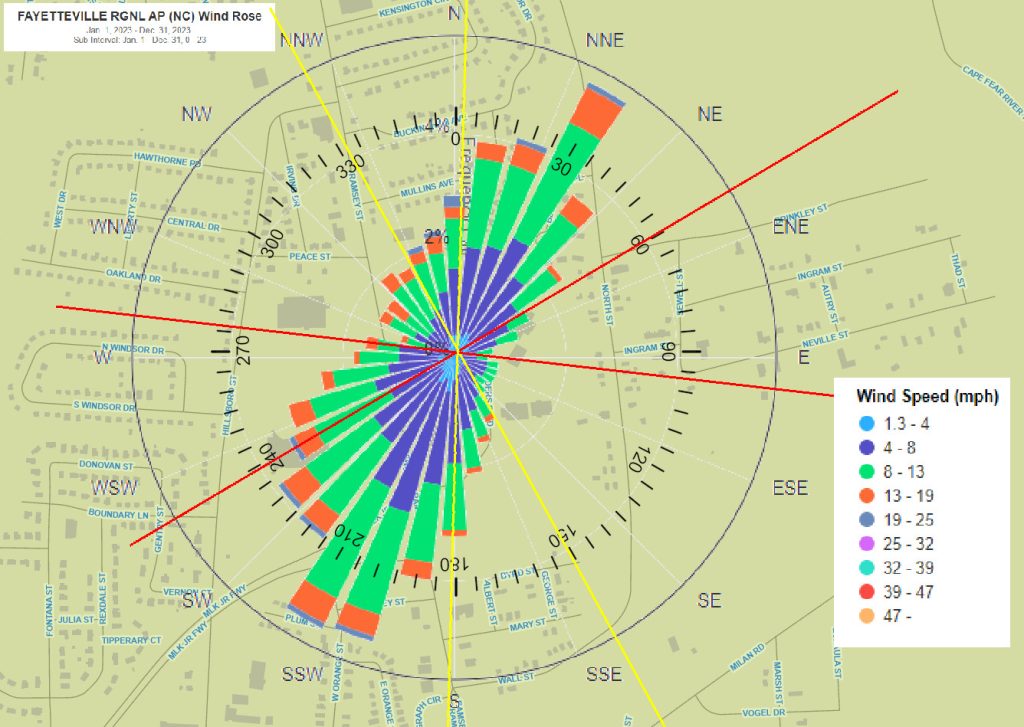
Any winds from Fay Block Materials affecting the Mary St. area would have to come from 330° – 360° [yellow lines]. Using the data chart we see that range covers three columns (330, 340, 350) which are 1.8%, 2.1%, and 2.2% respectively. This equals 6.1% of the year. This means that 94% of the time the wind is blowing in directions that can’t possibly affect residences in the Mary St. area.
Any winds from Fay Block Materials affecting the Fairview neighborhood would have to come from 240° – 275° [red lines]. Using the chart we can see that range covers four columns (240, 250, 260, 270) which are 3.3%, 3.2%, 2.4%, and 1.8% respectively. This equals 10.7% of the year. This means that 89% of the time the wind is blowing in directions that can’t possibly affect the Fairview neighborhood.
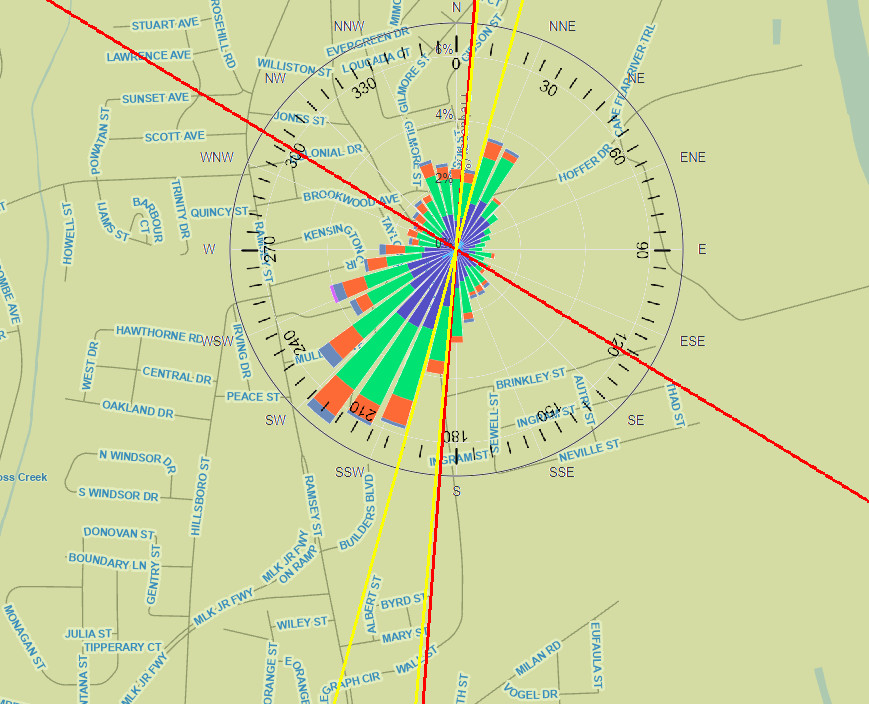
Any winds from the Hoffer storage area affecting the Mary St. area would have to come from 10° [yellow lines]. Using the chart we can see that range covers one column (10) which is 4.0%. This equals 4.0% of the year. This means that 96% of the time the wind is blowing in directions that can’t possibly affect the Mary St. area.
Any winds from the Hoffer storage area affecting the Fairview neighborhood would have to come from 300° – 360° [red lines]. Using the chart we can see that range covers six columns (300, 310, 320, 330, 340, 350, 360 [0])) which are 1.5%, 1.5%, 1.9%, 1.8%, 2.1%, 2.2%, and 2.9% respectively. This equals 13.9% of the year. This means that 86% of the time the wind is blowing in directions that can’t possibly affect the Fairview neighborhood.
“You can’t go outside and sit if the wind’s blowing,” Crosby said. “It’s so bad, you have to go inside your house. [CityView]
“The dust that’s floating in the air is ridiculous — and thank God I don’t hear the noise over on my side,” resident Joyce Holland said. “But the dust and the fumes in the air is just really bad. And I do have allergies, and at times it’s just horrible because of all this stuff that’s floating in the air.” [CityView]
“We have to march,” said Rita MacMillan, a member of the Fairview Concerned Neighbors Association. “We marched before we’ll march again. [CityView]
March on if you must, but I seriously doubt that anyone is going to be swayed when they discover that you’re nuisance free 86% – 96% of the time. Many neighborhoods don’t enjoy that high of a nuisance free level regarding life in general. Trust the science! The science is settled.
These numbers hardly equate to being a nuisance. When considering the impact of a nuisance, it is important to recognize that if one is free of it 86% to 96% of the time, its severity is significantly diminished. This high percentage of freedom indicates that the nuisance is infrequent and sporadic, allowing individuals ample opportunity to enjoy peace and comfort without constant disruption. Such limited exposure suggests that the nuisance, while perhaps bothersome when it occurs, does not pervade daily life to a critical extent. Consequently, the infrequency of the nuisance mitigates its overall impact, making it a minor inconvenience rather than a major issue.
Some will attempt to argue that wind speed and direction can vary a lot between Fayetteville Regional Airport and Fay Block Materials. No, it doesn’t. In fact, wind speed and direction is quite constant up to 30 miles out, even 60 miles out at times. A mere 7 mile distance is negligible when it come to wind speed and direction, unless you’re considering a tornado, of course.
What Did They Really Say:
Larry Wright, the bishop at Heal the Land Outreach Ministries and a former Fayetteville City Council member, became invested in helping the community after taking one of Bryant’s tours. “I came over a few months ago,” Wright said. “Bryant took me around, and just the trucks, breathing in the dust — I could taste the concrete almost, the cement dust in the air.” [CityView]
Qualifying words can sometimes be used to soften, modify, or hedge statements in a way that may obscure the truth or create ambiguity. The use of qualifying words is a strong indicator that a lie is being told, their strategic use can sometimes indicate an attempt to deceive or mislead. Here’s how qualifying words might play a role in such scenarios:
Creating Vagueness or Ambiguity – Qualifying words can make statements less direct and harder to pin down, allowing the speaker to avoid outright falsehoods while still misleading the listener.
Example:
- Without qualifier: “I could taste the concrete, the cement dust in the air.”
- With qualifier: “I could taste the concrete almost, the cement dust in the air.”
Common Qualifying Words and Phrases:
| Generally Mostly Usually May | Might Could Possibly Often | Almost Likely Appears to be Seems |
It is quite disheartening to see an alleged man of God stooping to such misleading misdirection. But then, Larry Wright is not known for being the most reverent or pious of men, so there’s that. Some people need to understand that; “It is better to remain silent at the risk of being thought a fool, than to talk and remove all doubt of it.”
The qualifier “almost” introduces ambiguity, suggesting there might be exceptions without specifying them. Qualifying words can be also used to overstate or exaggerate the severity of an issue. Using qualifiers can allow a speaker to make a statement that can later be denied or reinterpreted if challenged. The qualifier “almost” introduces doubt, providing an escape route if the statement is seriously questioned. Qualifiers use can often indicate an attempt to obscure the truth, reduce accountability, or create plausible deniability.
It is important to consider the context and the overall pattern of communication when evaluating whether qualifying words are being used to deceive. You’ll find that qualifying words are the backbone of the speech habits of liars, criminals and attorneys, not men of God.
- Unethical Media Personnel
• Sensationalism: Journalists or media figures who prioritize sensationalism over truth might use qualifiers to make headlines more eye-catching while avoiding outright falsehoods.
• Bias and Agenda: Media personnel with a bias might use qualifiers to present their preferred narrative while maintaining a veneer of objectivity. - Politically Motivated Individuals
• Spinning Narratives: Politicians or activists with unethical motives might use qualifiers to spin narratives that align with their agenda while avoiding outright lies.
• Manipulating Public Opinion: They can use qualifiers to subtly influence public opinion, planting seeds of doubt or belief without committing to verifiable facts. - Deceptive Manipulators
• Hiding the Truth: Individuals who wish to deceive others might use qualifiers to obscure the truth, making their statements ambiguous enough to avoid being caught in a lie.
• Creating Doubt: They can introduce qualifiers to create doubt and confusion, making it harder for others to discern their true intentions or the facts. - Avoiders of Responsibility
• Shirking Accountability: People who want to avoid taking responsibility for their actions or decisions may use qualifying words to leave themselves an “out” if things go wrong.
• Passing the Blame: By being vague or non-committal, they can shift blame onto others or claim they never made a definitive statement in the first place. - Manipulative Leaders
• Controlling Information: Leaders who wish to control or manipulate their audience might use qualifiers to ensure their statements can be interpreted in multiple ways, depending on the outcome.
• Maintaining Power: By keeping their statements intentionally vague, they can maintain power and flexibility, adjusting their stance as needed without appearing inconsistent. - Unethical Salespeople
• Misleading Promises: Salespeople who use qualifiers can make a product or service sound better than it is without committing to specific outcomes, thereby misleading potential buyers.
• Avoiding Guarantees: They might use qualifying words to avoid making guarantees or promises that they cannot fulfill, protecting themselves legally while still making the sale. - Dishonest Academics or Researchers
• Data Manipulation: Unethical researchers might use qualifiers to present skewed data or inconclusive results in a more favorable light, leading to misleading conclusions.
• Avoiding Scrutiny: By using qualifiers, they can avoid direct scrutiny of their work, making it harder for peers to challenge their findings effectively.
While qualifying words can be used responsibly to convey nuance and uncertainty, they can also be employed unethically to deceive, manipulate, and avoid accountability. Recognizing when qualifiers are being used for unethical purposes requires critical thinking and an awareness of the speaker’s potential motives and the context in which they are communicating.
Why would they lie?
While a few concerns residents have about nearby industries are legitimate, there are instances where the motivations behind false allegations and attempts to stifle industrial growth can be less than noble. Here are some reasons why residents might engage in such behavior:
- Financial Gain
- Extortion: Residents or groups may make false claims to pressure the industry into offering financial settlements or concessions to avoid bad publicity or legal battles.
- Property Value Manipulation: Homeowners might spread false information to devalue properties temporarily, allowing them to buy more property cheaply before reselling at a higher price once the industry is driven out.
- Competitive Interests
- Business Competition: Competing businesses might encourage or support false allegations to hinder the growth of an industrial competitor, thereby gaining a market advantage.
- Real Estate Development: Developers interested in acquiring industrial land at lower prices might instigate or support community opposition to force industries to relocate.
- Political or Ideological Agendas
- Political Gain: Local politicians or activists might use opposition to an industry to rally support for their own political agendas, even if the opposition is based on falsehoods.
- Ideological Warfare: Groups with strong ideological stances against certain types of industries (e.g., fossil fuels, chemicals) might spread misinformation to further their broader environmental or social justice causes.
- Personal Vendettas
- Revenge: Individuals with personal grudges against the industry or its leaders might spread false information out of spite or a desire for retribution.
- Former Employees: Disgruntled former employees might instigate false allegations to harm their previous employer.
- Attention Seeking
- Publicity: Some individuals might engage in sensationalism to gain attention, recognition, or a platform for themselves within the community or media.
- Activist Reputation: Activists might exaggerate or fabricate issues to build their reputation as defenders of the community, thereby gaining social or professional status.
- Social Influence
- Group Dynamics: Social leaders or influential community members might rally others based on false claims to strengthen their own influence and control over the neighborhood.
- Peer Pressure: Residents might support false allegations due to pressure from neighbors or community groups, fearing social ostracism if they do not conform.
- Legal Manipulation
- Lawsuits: False allegations can be used to initiate legal actions that can drain the industry’s resources, leading to settlements or shutdowns regardless of the truth.
- Regulatory Pressure: By making false claims, residents might trigger regulatory investigations that can impose costly compliance measures on the industry, making it difficult for them to operate.
While these motivations are not representative of all community opposition to industrial activities, they do highlight the complex and sometimes underhanded tactics that can be employed. It underscores the importance of thorough investigations, transparent communication, and fair legal processes to ensure that all claims are properly vetted and addressed based on factual evidence.
Fact Review:
A review of the facts at this point is helpful;
- Fay Block Company is grandfathered-in at their location because they were established at that location in 1945. Fay Block Materials was not annexed until the same year that city of Fayetteville created their zoning ordinances, in 1949. Fay Block Materials is not going away and they can not be forced to go away as they enjoy the legal protections afforded them under;
- Grandfather Clause: This is a provision in which an old rule continues to apply to some existing situations while a new rule will apply to all future cases.
- Priority Rule: This is a fundamental concept in various areas of law, particularly in property law and intellectual property law. The rule of “first in time, first in right” often applies.
- People need the product produced by Fay Block Materials. Residents and businesses demand the benefits of the materials that Fay Block Materials produces that allow people to build safer and sturdier structures. Ask yourself; are there many homes or businesses in Cumberland county that do not have any Fay Block Material products in their construction?
- Concrete is necessary for residential and business footers.
- Concrete is necessary for driveways residents and businesses want.
- Concrete is commonly used for residential and business floors.
- Concrete pavers are used for residential and business sidewalks and landscaping features.
- Concrete is used in roadways and roadway safety devices.
- Only three other residences were present in the immediate location at the time Fay Block Materials established themselves in that area before becoming subject to Fayetteville annexation and zoning ordinances. All other residences in that area came AFTER Fay Block Materials had established themselves. And even these three locations have passed out of the original owner’s control over the years. This makes Fay Block Materials the only current remaining “first in time, first in right” due to their having four generations of consistent familial ownership. However, if these three residences choose to fight amortization and want to stay where they are, there can certainly be a nonconforming variance issued with the understanding that they must accept the continuation of the industrial uses, even if they cause nuisance issues such as noise, odor, or traffic.
- 1011 George St. – Anthony Blue – Current Deed: 03/26/2015
- 1015 George St. – Deborah D. Blue – Current Deed: 07/30/1991
- 1010 Albert St. – Debrah/Winston Hall – Current Deed: 04/04/2021
- Improper Zoning by the City of Fayetteville
- Since Fay Block Materials was grandfathered-in and had the rule of “first in time, first in right” supporting them the city of Fayetteville had no choice but to zone their annexed land as industrial. Fayetteville should have never zoned any adjoining land in that area as residential. But they did. And to compound the issue Fayetteville went on to zone much of the surrounding area as commercial, light industrial and heavy industrial.
Key Zoning Points to Consider:
Differentiated Zoning Purposes
Different Goals: Industrial, commercial, and residential zones have different goals and serve different community needs. Residential zones focus on providing safe and pleasant living environments, commercial zones on promoting business activities, and industrial zones on accommodating manufacturing and other heavy uses.
Specific Regulations: Each type of zone has specific regulations that address the particular needs and impacts associated with that use. For instance, industrial zones may have more lenient noise and emissions regulations compared to residential zones.
Equal Protection Under the Law
Constitutional Basis: The Equal Protection Clause of the 14th Amendment ensures that no state shall deny any person within its jurisdiction the equal protection of the laws. This means zoning laws must apply fairly and consistently to all property owners, even industrial property owners.
Non-Discrimination: Zoning regulations must not discriminate arbitrarily between different types of uses or property owners. This means that Fay Block Materials can not be discriminated against just because they’re an industrial entity. Any distinctions made must have a legitimate governmental purpose and be rationally related to achieving that purpose.
Due Process
Procedural Due Process: Property owners must be given notice and an opportunity to be heard before any zoning changes affecting their property are made.
Substantive Due Process: Zoning regulations must have a legitimate public purpose and not be arbitrary or capricious. This ensures that zoning decisions are made with fairness and reason.
Amortization:
If the Fairview residents living in non-conforming residential zones within this clearly industrial area are now experiencing health issues, noise, and odor complaints, it is time to eliminate these incompatible residential uses. This can be accomplished by residential amortization, ensuring the area aligns with the more logical industrial zoning designation. The justification would clearly be “for the health and welfare of the residents”. After all, the city of Fayetteville shouldn’t allow the residents to continue to place themselves in harm’s way. That would be unconscionable. They should be made to vacate the area for their own good.
Amortization – The process through which nonconformities are required to come into compliance with applicable regulations.
Fayetteville can’t legally force Fay Block Materials to move or shut down their operations. Fay Block Materials was there first. And besides, residential property carries no special consideration above that of commercial or industrial properties. Though Fayetteville can legally control development in the city by zoning, were Fayetteville to give residential properties any kind of preference over commercial and industrial properties it would be illegal and unconstitutional. And the city of Fayetteville can certainly amortize those residents seeing as how they do not have the protection of being grandfathered-in or are able to exercise “first in time, first in right” defenses as can Fay Block Material.
There have been examples of communities facing environmental concerns related to living near industrial, commercial or other environmentally unsafe zones who have been amortized. Here are a few examples showing that residential amortization can, and has, been done:
- West Calumet Housing Complex, Indiana (2016)
- Background: The West Calumet Housing Complex, located in East Chicago, Indiana, was built on a former industrial site with a history of heavy industry, including lead smelting operations. The area was designated as a Superfund site due to high levels of lead and arsenic contamination.
- Health Concerns: Residents of the West Calumet Housing Complex reported elevated levels of lead in their blood, leading to concerns about lead poisoning and other health impacts, particularly in children.
- Amortization and Relocation: In 2016, the U.S. Environmental Protection Agency (EPA) ordered the evacuation and relocation of over 1,000 residents from the West Calumet Housing Complex due to the health risks posed by lead contamination. The city provided assistance to help residents find new housing in safer areas.
- Oakridge, Tennessee (1940s-1950s)
- Background: Oakridge, Tennessee, was a secretive industrial site during World War II, where uranium was enriched for the Manhattan Project. After the war, the area became a residential community, but concerns emerged about radioactive contamination left behind by the nuclear activities.
- Health Concerns: Residents of Oakridge began to express concerns about potential health risks associated with living near radioactive contamination from the former nuclear facilities.
- Amortization and Relocation Efforts: In the 1940s and 1950s, the federal government initiated efforts to relocate residents from Oakridge to safer areas. These efforts were part of broader initiatives to address the environmental and health impacts of the nuclear activities in the area.
- Times Beach, Missouri (1980s)
- Background: Times Beach, a small town in Missouri, gained national attention in the 1980s when it was discovered that the town’s dirt roads had been sprayed with waste oil contaminated with dioxin, a highly toxic chemical. The contamination resulted from a waste oil spraying program aimed at controlling dust on the roads.
- Health Concerns: Dioxin exposure was linked to various health issues, including cancer and birth defects. As a result, the Environmental Protection Agency (EPA) declared Times Beach uninhabitable due to the health risks posed by the contamination.
- Amortization and Relocation: In 1983, the federal government initiated a voluntary buyout program, offering to purchase homes in Times Beach at fair market value. Most residents accepted the buyout, and the town was disincorporated in 1985. The area was later cleaned up and transformed into Route 66 State Park.
- Love Canal, New York (1970s)
- Background: Love Canal, a neighborhood in Niagara Falls, New York, became infamous in the late 1970s due to widespread contamination with toxic chemicals, including dioxins, benzene, and other hazardous substances. The contamination stemmed from buried chemical waste from a former landfill owned by the Hooker Chemical Company.
- Health Effects: Residents reported numerous health issues, including high rates of cancer, birth defects, and other serious illnesses. The contamination garnered national attention and led to the passage of the Comprehensive Environmental Response, Compensation, and Liability Act (CERCLA) in 1980.
- Amortization and Relocation: In 1978, President Jimmy Carter declared a federal emergency in Love Canal, and over 800 families were evacuated from the area. The federal government purchased homes from residents, and the neighborhood was declared a Superfund site for cleanup and remediation efforts. The relocation and cleanup process spanned several years and involved significant government intervention and community involvement.
- Picher, Oklahoma (2006-2009)
- Background: Picher, Oklahoma, was part of the Tar Creek Superfund site, one of the most toxic areas in the United States due to extensive lead and zinc mining. The area was heavily contaminated with lead, cadmium, and other toxic substances.
- Health Concerns: High levels of lead contamination in the soil and water posed severe health risks, particularly to children, leading to increased rates of lead poisoning and other health issues.
- Amortization and Relocation: In 2006, the federal government initiated a buyout program for the residents of Picher through the Environmental Protection Agency (EPA) and other agencies. The buyout was part of a formal process to relocate residents away from the contaminated area. By 2009, most of the town’s residents had accepted the buyout offers and relocated, and Picher was officially disincorporated in 2009.
- Centralia, Pennsylvania (1980s-present)
- Background: Centralia, Pennsylvania, was a small town built on a rich seam of anthracite coal. In 1962, a coal mine fire ignited beneath the town, and it has been burning ever since, causing dangerous levels of carbon monoxide and other hazardous gases to seep into the town.
- Health and Safety Concerns: The ongoing fire created dangerous living conditions due to sinkholes, toxic gases, and high temperatures, posing severe health and safety risks to the residents.
- Amortization and Relocation: In the 1980s, the federal government declared Centralia unsafe for habitation. A formal buyout and relocation program was established, offering residents fair market value for their properties. The majority of residents accepted the buyout and relocated. Today, Centralia is mostly abandoned, with only a few residents remaining.
Undeniably, instances of forced relocation or voluntary buyouts have occurred in communities facing significant environmental concerns related to nearby industrial activities. These cases underscore the importance of addressing and protecting public health in communities near industrial or commercial zones by the use of proper zoning and residential amortization to accomplish proper zoning.
Eliminating a residential element from an industrial area, especially if the residential zoning was a mistake or is now deemed incompatible, is a standard legal process. Municipalities must navigate legal constraints and ensure fairness to affected property owners. Here are the legal means and strategies that can be considered:
- Re-Zoning
- Re-Zoning to Industrial: The municipality can initiate a re-zoning process to change the residential zoning to industrial. This involves public hearings, community input, and approval from the planning commission and city council.
- Legal Procedures: Proper legal procedures must be followed, including notice to affected property owners and opportunities for public comment. Re-zoning must be justified by a comprehensive plan or public need. In this case the public need would be for the health and safety of the residents who should not have been allowed to build so close to an existing industrial area in the first place. Fayetteville owes it to these residents to get them moved out of that area.
- Eminent Domain
- Public Use Justification: Eminent domain allows the government to take private property for public use with just compensation. The municipality must justify that the taking is for a public purpose, such as economic development, infrastructure improvements, or eliminating incompatible land use. Again, the justification would be for the health and safety of the residents who should not have been allowed to build so close to an existing industrial area in the first place. Fayetteville owes it to these residents to get them moved out of that area.
- Just Compensation: Property owners must be provided with fair market value compensation for their property. This can be costly and legally contentious, requiring negotiations or court proceedings to determine adequate compensation. But, since it was the city of Fayetteville who failed to exercise their due diligence and adequately protect these citizens then it obviously falls on the city of Fayetteville to “bite the bullet” and do the proper thing and get those residents moved out of that area for their own health and safety.
- Purchase and Relocation Assistance
- Voluntary Purchase: The municipality can offer to buy out residential property owners voluntarily. Offering financial incentives above market value may encourage property owners to sell.
- Relocation Assistance: Providing relocation assistance, including financial support for moving expenses and assistance in finding new housing, can make the process more palatable for residents.
- Development Agreements and Incentives
- Negotiated Agreements: The municipality can negotiate development agreements with property owners, offering incentives such as tax breaks or grants for relocating.
- Redevelopment Plans: Incorporating the relocation into broader redevelopment plans can provide a framework for transitioning residential areas to industrial use over time.
- Phasing Out Through Amortization
- Amortization Ordinance: Commonly used for nonconforming properties, an amortization ordinance can easily be applied to residential properties. This would set a period during which residential uses must be phased out. A clear justification certainly exists for amortization of the residences to occur, that being for the health and safety of those residents. After all, it is the residents themselves who are citing health, noise, and odor concerns. While unverified, these residents are citing cancers are being caused by ‘dust’ in the area. If this is the case then it’s clear that these residents have to be amortized and forced towards safer areas.
- Economic Hardship Considerations: The amortization period must be reasonable to avoid claims of regulatory taking without just compensation. A ten (10) year span of time is usually considered sufficient.
- Addressing Nonconforming Use
- Nonconforming Use Regulations: If residential properties are considered nonconforming uses, municipalities can implement regulations that prevent expansion or significant alteration, gradually reducing their presence.
- Property Value and Investment: While regulations must consider the property value and investment to avoid undue economic hardship on residents, the health and noise factor must take precedence over property value and investment. The residents’ knew, or reasonably should have known, of the presence of Fay Block Materials before they built, bought, or rented in the area. Remember; Fay Block Materials has an undeniable legal claim of being “grandfathered-in” and “first in time, first in right” over any of these existing residents.
- Public Health and Safety Justifications
- Health and Safety Concerns: If the residential use poses a significant risk to public health and safety due to industrial activities, the municipality can use this as a basis for residential relocation. This can be documented and substantiated by studies or expert testimony.
Eliminating a residential element from an industrial area involves navigating standard common legal and social challenges. The municipality must balance the need for industrial zoning with any rights or well-being of residential property owners. This means that residentially zoned areas don’t automatically get special consideration with regard to zoning disputes. Legal means include re-zoning, eminent domain, voluntary purchase, development agreements, and common amortization ordinances. Success depends on thorough planning, fair compensation, community engagement, and legal compliance to ensure a just and effective transition.
The area shaded in red on the zoning map represents the recommended 1,000 foot buffer that should have been established between Fay Block Materials and the residents.
However, the areas north of the railway don’t seem to be affected as there have been no dust complaints from Mullins Ave. or Buckingham Ln. that could be located. Since they have not complained then it’s possible that they need not be disturbed.
Blueberry Pl. is under control of the city of Fayetteville Metropolitan Housing Authority anyway so those occupants can be easily relocated. There are 63+ remaining residences that would have to be vacated under an amortization process. This is actually a relatively small inconvenience and price to pay considering the number of lives that would be saved if the complaints of the residents are to be believed. Remember; “For the children”, it must be done for the children!
Fairview residents should understand that this situation does not present an opportunity to artificially inflate the prices of their homes in hopes of profiting at the expense of the city’s taxpayers. They would receive only the fair market value for their properties, comparable to what they would have received had they sold their homes yesterday. This ensures a fair and just process for all parties involved.
On review, you should have no trouble seeing that this is a very doable solution to all the complaints by these residents. One of the opposing parties has to go, and since it will not be Fay Block Materials as they are the innocent victims in this matter in addition to having “grandfathered-in” and “first in time, first in right” legal doctrine protecting them, it is the residents that must go for their own protection. The city of Fayetteville should never have let residences encroach on Fay Block Materials. The city of Fayetteville must do it “For the children”!
As for the cemetery, that’s not an issue. The residents there do not breathe, they sleep very soundly so noise doesn’t bother them and no odors can penetrate their ‘homes’.
There is also the question of whether Fay Block Materials is a “bad actor” regarding pollution. Again we refer to the North Carolina Department of Environmental Quality | Division Air Quality files. The latest inspection report conducted shows that Fay Block Materials has easily passed all environmental requirements and looking through several of their past inspections reports I saw no indication that Fay Block Materials is in any way a bad actor when it comes to area pollution. Again; only ONE violation in 14 years, 7 months, 3 days.
Fayetteville’s Master Plan:
Fayetteville has an ordinance, and within that ordinance exists a “Master Plan.” This master plan cites quite clearly that properties along a planned development district shall be compatible with existing development and that where there are issues of incompatibility a transitional area must be created. Since Fay Block Material is grandfathered-in and has “first in time, first in right” in any zoning disputes as determined by the courts, it’s obviously time to move those Fairview residents.
30-3.G.2. General Standards for All Planned Development Districts (c) Compatibility with Surrounding Areas
Development along the perimeter of a PD district shall be compatible with adjacent existing or proposed development. Where there are issues of compatibility, the Master Plan shall provide for transition areas at the edges of the PD district that provide for appropriate buffering and/or ensure a complementary character of uses. Determination of complementary character shall be based on densities/intensities, lot size and dimensions, building height, building mass and scale, hours of operation, exterior lighting, siting of service areas, or other aspects identified by the City Council.
This is a list of the residences that would potentially be affected by amortization. Not listed is Blueberry Pl. which is owned by Fayetteville already, or any address north of the railway since no complaints seem to have ever originated from those addresses. What remains is a compilation of the complainers. For Fayetteville to amortize these properties and purchase them would require only approximately 2.5 million dollars. Keep in mind that a significant portion of this expenditure would be reclaimed on resale of these properties to entities that would comply with the rezoning of these properties to commercial or industrial. This means that such an expenditure wouldn’t even come close to a permanent loss to Fayetteville.
And since the city of Fayetteville can casually proffer a sum of $500,000 to the airport for advertisement and another $500,000 to the Cape Fear Theater for… theater, it doesn’t appear that this would be a burden to Fayetteville at all.
Additionally, one would think that the airport and Cape Fear Theater would have no problem with these funds being deferred from them this year to save lives, to save those Fairview residents who say they’re in danger of death where they chose to live. Remember; “It’s for the children”!
District 2 Fayetteville City Council member Malik Davis needs to step up to the plate and get the ball rolling as this issue according to the residents is life threatening. Council member Davis needs to start preparing his constituency to move to locales that are more to their liking as it’s clear that they’re not happy where they’re at. It would also be incumbent on Council member Davis to establish provisions for relocation assistance, including financial support for moving expenses and assistance in finding new housing that can make the process more palatable for residents.
Remember Council member Davis, it’s for the children. We can’t forget the children!
Council member Davis can certainly begin by tasking the Economic & Community Development Department with shouldering the brunt of the amortization. A good start would be;
- Deferring all those monies set aside for the Murchison Rd. project should not be a problem. After all, according to the Fairview residents, this is an emergency. Surly the denizens of Murchison Rd. wouldn’t begrudge waiting a little longer so that their brethren can be assisted.
- Deferring that $500,000 that is earmarked for the Cape Fear Theater would surely be a great boon to the amortization effort to move those people to safety.
- Deferring that $500,000 that is earmarked for the airport for “advertising” towards assisting the potentially 63+ Fairview residents that would be displaced. I think everybody knows that we have an airport and where it is.
- Deferring the monies being used to “provide transitional housing to 19 individuals as they re-enter society after incarceration” towards assisting 19 of the potentially 63+ Fairview residents that would be displaced. Surely good honest citizens should get assistance before common criminals.
- Deferring those monies in the Good Neighbor Program to assist all eligible City employees with up to a $30,000 forgivable loan to purchase their home within the City limits shouldn’t be a problem. After all, “it’s for the children”!
- Deferring the monies assigned to those “variety of loans and matching grants to businesses looking to purchase real property or improve the exteriors of their businesses” towards assisting the potentially 63+ Fairview residents that would be displaced.
- Of course, Down Payment Assistance that the city provides to low, moderate, and workforce income levels that provides up to $20,000 in matching funds toward the purchase of their home within the city limits of Fayetteville should be utilized to assist the potentially 63+ Fairview residents that would be displaced.
- Deferring those monies set aside by the Parks, Recreation and Maintenance Department for “Installing automatic park gates at Lake Rim Park and Arnette Park”. Surely they can continue to manually open and close those gates a little while longer. Remember; It’s “For the Children”! And to assist the potentially 63+ Fairview residents that would be displaced.
- And the ECDD should be able to leverage that variety of nonprofits they partner with annually to provide critical funding for services aimed at benefitting low and moderate income households to assist in the amortization.
That’s just a few of the areas Council member Davis can resource to finance and facilitate a life saving residential amortization. And this amortization process would certainly be an achievement of five of Fayetteville’s six goals, if not all six of them;
- Goal 1: Safe & Secure Community
- Goal 2: Responsive City Government Supporting a Diverse and Viable Economy
- Goal 3: City Investment in Today and Tomorrow
- Goal 4: Desirable Place to Live, Work and Recreate
- Goal 5: Financially Sound City Providing Exemplary City Services
- Goal 6: Collaborative Citizen and Business Engagement
Example Amortization Ordinance for Non-Conforming Residential Area:
An amortization ordinance is not that difficult to craft. Here is an example, a template if you will, of such an ordinance. You’re welcome.
Ordinance No. [XXXX]
An Ordinance to Eliminate Residential Uses in the Non-Conforming Area and Transition to Industrial Zoning
Section 1: Purpose and Intent
The purpose of this ordinance is to eliminate residential uses in the non-conforming area, ensuring the area aligns with the industrial zoning designation. This transition aims to promote economic development, protect public health and safety, and ensure a harmonious urban environment. This ordinance provides for a structured and fair process, including thorough planning, fair compensation, community engagement, and legal compliance.
Section 2: Definitions
Non-Conforming Area: The designated area currently zoned for residential use but located within an industrial zone, as outlined in Appendix A.
Non-Conforming Use: Residential properties within the non-conforming area that do not conform to the current industrial zoning regulations.
Amortization Period: The designated timeframe during which residential uses must be phased out.
Section 3: Amortization Period
Duration: The amortization period for the non-conforming residential uses shall be [10 years] from the effective date of this ordinance.
Transition Plan: A detailed transition plan shall be developed and implemented, providing a timeline for the phasing out of residential uses.
Section 4: Fair Compensation
Fair Market Value Compensation: Property owners in the non-conforming area shall be compensated at fair market value for their properties. Independent appraisals will be conducted to determine fair market value.
Relocation Assistance: The municipality shall provide relocation assistance to affected residents, including moving expenses and support in finding alternative housing.
Section 5: Community Engagement
Public Hearings: Prior to the adoption of this ordinance, the municipality shall hold a series of public hearings to gather input from affected residents and stakeholders.
Advisory Committee: An advisory committee composed of community representatives, industrial operators, and municipal officials shall be established to oversee the transition process and address concerns.
Regular Updates: The municipality shall provide regular updates to the community on the progress of the transition and any developments.
Section 6: Legal Compliance
Compliance with State and Federal Laws: The ordinance shall comply with all relevant state and federal laws, including the Uniform Relocation Assistance and Real Property Acquisition Policies Act.
Appeals Process: A clear appeals process shall be established for property owners who wish to contest the compensation or other aspects of the ordinance.
Section 7: Implementation
Implementation Plan: The municipality shall develop and publish a comprehensive implementation plan detailing the steps, timeline, and responsibilities for executing the transition.
Monitoring and Reporting: The municipality shall monitor the implementation of the ordinance and report on progress annually to the city council and the public.
Section 8: Severability
If any section, clause, or provision of this ordinance is declared invalid or unconstitutional by a court of competent jurisdiction, such declaration shall not affect the validity of the remaining sections, clauses, or provisions.
Section 9: Effective Date
This ordinance shall take effect on [Date], following its adoption and publication as required by law.
Adopted this [Day] of [Month], [Year] by the City Council of [Municipality].
Mayor: [Name]
City Clerk: [Name]
To summarize;
- Myron Pitt’s opinion hit pieces against Fay Block Materials are unethical, unprofessional, and extremely biased by leaving out relevant information.
- Fay Block Materials is not the villain certain local media sources are making them out to be.
- Fay Block Materials is a vital component to the survival and success of the city of Fayetteville.
- Fay Block Materials has the legal protections of being grandfathered-in and the Priority Rule: “first in time, first in right”.
- Fay Block Materials has only had one (1) environmental violation in 14 years and excessively emphasizing and inflating a single violation, turning a minor issue into a major crisis is inappropriate and unethical.
- The empirical MRCC data regarding prevailing winds over Fay Block Materials (Fayetteville) does not support accusations of “sandstorms” affecting either neither George, Byrd, Albert, Mary and Wall streets nor the Fairview neighborhood.
- False reports of pollution (sandstorms) against Fay Block Materials by Fairview Residents has occurred and are inappropriate, unethical, and illegal.
- MRCC wind data objectively verifies that George, Byrd, Albert, Mary and Wall streets and the Fairview neighborhood are nuisance free of any air borne effects of being near Fay Block Materials 86% to 96% of the time.
- Fay Block Materials is not ‘racist’, has never controlled, and does not control, who builds, buys, or rents property outside of their own holdings.
- It is the city of Fayetteville’s policy and legal mandate in ordinances that the protection and expansions of existing businesses is required.
- There is no such thing as environmental racism.
- Not all pollution is the responsibility of the polluter.
- Even industrial businesses have “equal protection under the law” when in zoning disputes with residentially zoned areas.
- Race, Color, National Origin, Sex, Religion, Or Age of the involved parties are legally irrelevant in resolving zoning issues.
- Where there are issues of [in]compatibility, the [Fayetteville] Master Plan shall provide for transition areas at the edges of the PD district that provide for appropriate buffering.
- Residential amortization is a common and sensible solution for communities to use facing environmental concerns related to living near industrial, commercial or other environmentally unsafe zones.
- Eliminating a residential element from an industrial area, especially if the residential zoning was a mistake or is now deemed incompatible, is a standard legal process.
- Fairview residents artificially inflating the prices of their residences in anticipation of making a small fortune by gouging the city’s taxpayers is not an option.
- For a mere 2.5 million recoverable dollars the city of Fayetteville can permanently quiet a perpetual source of complaint and irritation to local business.
- Since the city of Fayetteville can casually proffer a sum of $500,000 to the airport for advertisement and another $500,000 the Cape Fear Theater for… theater, it doesn’t appear that this would be a burden to Fayetteville at all.
- It’s time for the city of Fayetteville to correct its mistakes.
Time to get busy Fayetteville City Council. Looks like you got an amortization to construct to save those Fairview lives. It’s for the children!
Sources:
- https://edocs.deq.nc.gov
- https://online.encodeplus.com/regs/fayetteville-nc/doc-viewer.aspx?tocid=005.030#secid-9269
- https://www.windfinder.com/#9/34.9906/-78.9999/spot
- https://cumberlandgis.maps.arcgis.com/apps/webappviewer/index.html?id=a6ea68995c2349e9a177366288589be7
- https://faync.maps.arcgis.com/apps/Embed/index.html?webmap=40491d2f172d48418316c8aa7e7e36ad&extent=-79.1871,34.9468,-78.6801,35.233
- https://www.fayettevillenc.gov/city-services/budget-evaluation-4400
- https://mrcc.purdue.edu/CLIMATE/welcome.jsp

